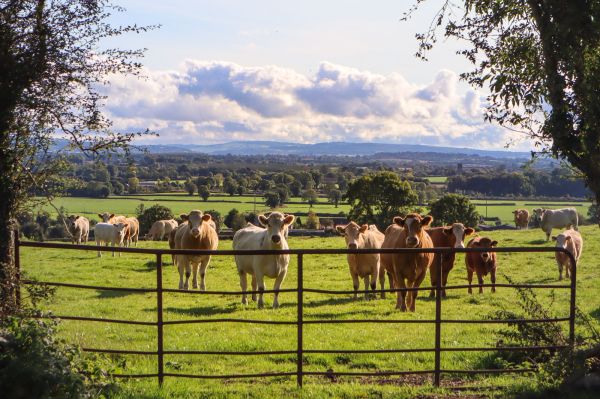On a quest to reduce finishing age

Paul Smith, Mark McGee, Bernadette Earley, Edward O’Riordan, Paul Crosson and David Kenny from Teagasc Grange, and Alan Kelly from University College Dublin (UCD) outline the new Beef-Quest project, which aims to identify the key factors affecting the lifetime live weight gain performance of the national beef herd
As part of the Irish Climate Action Plan, a 25 per cent reduction in agricultural greenhouse gas (GHG) emissions (from 22Mt of carbon dioxide (CO2) equivalent (eq) to 17.25Mt CO2eq), by 2030 was established. For the beef sector, reducing the average finishing age of the national prime beef cattle population (i.e. steers, heifers, and young bulls), from 26 to 22-23 months has the potential to reduce agricultural GHG emissions by 0.73Mt CO2eq. Indeed, analysis conducted as part of the latest Teagasc Marginal Abatement Cost Curve (MACC) highlighted a reduction in the finishing age of prime beef cattle to contribute towards 15 per cent of the Irish agricultural sector’s 2030 GHG reduction target.
Finishing-age potential
By reducing the finishing age of beef cattle, it is possible to reduce the overall quantity of GHG emissions (predominantly methane – CH4) an animal emits over their lifetime. For example, if a steer undergoing finishing was emitting on average 230g of methane per day, a one-month (28 days) reduction in finishing age, would produce a CH4 saving of 6.4kg or 180kg of CO2. Beyond the environmental benefits, reducing the finishing of beef cattle is economically advantageous, by decreasing the daily input cost associated with rearing an animal, and thus is a key contributor to on farm profitability. Although much of the GHG emissions benefits are likely realised when the animal is older, and subsequently emitting a higher proportion of GHG emissions, an overall improvement in live weight gain across all stages of the animals lifetime, will ultimately reduce the overall time required to produce an animal, and benefit the daily input costs associated with raising beef cattle.
What’s the problem?
Since 2010, the average finishing age of the Irish prime beef cattle population has reduced by roughly two months of age, with minimal impact to the average carcass weight. For example, the average finishing age of suckler-bred steers has reduced by ~1 week/annum with a slight increase to average carcass weight. However, in spite of this, nationally the mean age at finishing is six-to-nine months later than achieved on grass-based high-performing commercial and beef research farms. Therefore, in order to expedite a reduction in the average finishing age of the prime beef cattle population, there is an urgent need to identify and quantify the key factors currently impeding Irish beef farms from achieving potential live weight targets throughout the animal's lifetime.
On a quest
The Teagasc-led Beef-Quest project, recently funded by the Department of Agriculture, Food and the Marine, aims to investigate the effects of nutrition, health, and on-farm environment factors presently constraining animal-growth performance and the finishing age of cattle on beef farms, and to assess their impacts on GHG emissions and on farm profitability. In collaboration with the Irish Cattle Breeding Federation (ICBF) and UCD, the Beef-Quest project will undertake a multifaceted approach to identify the key factors impeding lifetime live weight performance on commercial beef farms, and assess the barriers to technology adaption on farm. Using data currently available within the industry from commercial suckler- and dairy-bred beef farms, the lifetime weight gain performance of the national beef herd will be characterised to help identify key junctures in the production cycle, whereby growth targets are currently not being achieved on commercial farms.
Following this, a new large-scale, on-farm study is planned to determine the key animal nutrition, health and on-farm environmental related factors presently constraining growth performance, and subsequently contributing to the older finishing age of cattle on Irish farms. Data amassed from the on-farm study, will be utilised to determine both the environmental and economic benefits associated with the optimisation of animal nutrition, health and on-farm environment, and subsequently aid the identification of the most effective on farm measures for reducing the finishing age of Irish beef cattle.
Finally, through a series of interviews and surveys with farmers, the fundamental sociological factors underpinning key production decisions on farms which impact finishing age, will be investigated in order to assess the likelihood of uptake and adoption at farm level, of some of the key strategies identified as part of this project.
Targeted solutions
Overall, Beef-Quest will identify, quantify and rank the primary on-farm technical and behavioural-related bottlenecks negatively impacting beef cattle finishing age. Using this new information more targeted, high-impact and deliverable solutions can be proposed and disseminated to reduce the finishing age of cattle, thus improving the sustainability of Irish beef production. A roadmap for policy makers and the wider agricultural industry, will be formulated detailing the most effective means of reducing the national finishing age whilst maintaining both beef production levels and international reputation of Irish grass-based beef production.
The Beef-Quest project has been funded by the Department of Agriculture, Food and the Marine’s Competitive Research Funding Programme (grant number: 2023RP892).
Teagasc Beef Open Day
Details of the Beef-Quest project as well as other key research focused on animal nutrition, genetics, breeding, grassland management and GHG mitigation, will be presented at the Teagasc Beef Open Day on June 26 in Teagasc Grange (Eircode: C15 PW93). For up-to-date information on the open day, please visit the Teagasc website and Teagasc Beef social-media channels.




